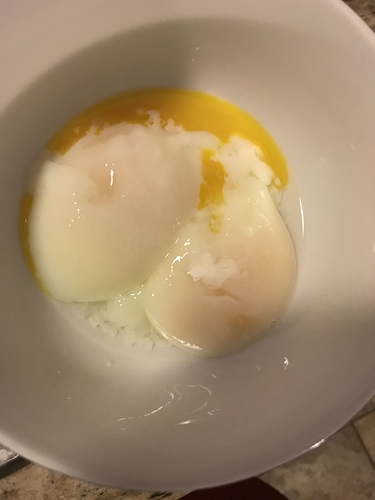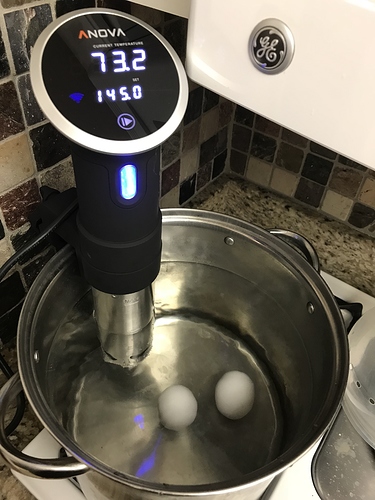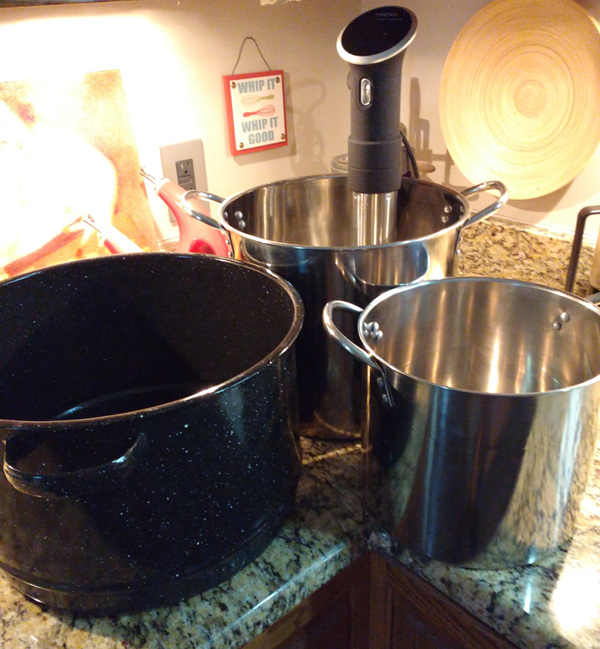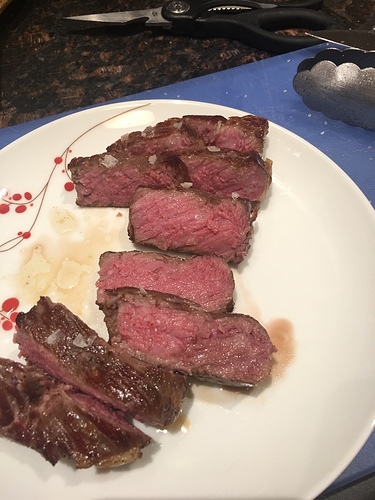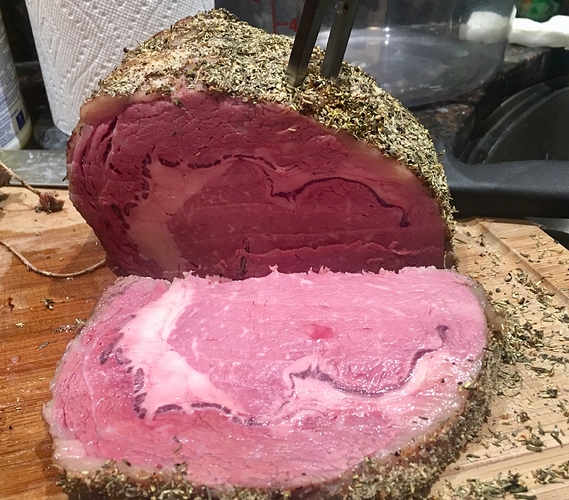Wouldn’t surgical grade have to do with the material not breaking up, decomposing, or interacting with anything in the body. And human body temperature is considerably lower than sous vide cooking temps for a steak. But still I’m guessing even 165 degrees for USDA chicken is still too cold to hurt the plastic bags or silicone in any way even for a long period of time, and 24 hours probably isn’t even very long.
A Sous Vide Primer (how to get started and why with a ketogenic lifestyle)
I haven’t had any problems with any stainless racking oxidizing in my Sous Vide vessel. People need to avoid chrome though - it always rusts at the weld points. Really not intended for this purpose. (though I did use a Weber BBQ rib rack to sous vide my ribs for the first year and a half before I got my LIPAVI rack) 
It worked quite well (and was cheap!):
Seems the folks at LIPAVI only like the Americans - their racks are ungodly expensive in Canada and the UK.
Just jumped into the sous vide “rabbit hole” with both feet. After doing a lot of reading (and MAN what a rabbit hole that turned out to be … and I still know very little) I ordered the Anova 2nd Gen alog with the 12 liter Rubbermaid container and the top with the opening for the Anova. Was going to try a chuck roast but had guests coming over this past Sunday and didn’t have time according to the recipes I read. Picked up a pair of large round steaks (sometimes sold as London Broil) as I figured this would be a good tenderizing test. Even slow cooked in my smoker, these big round steaks can have the texture and tenderness of hiking boot soles.
To make a short story long, I cooked these up in the sous vide, seared them over a hot grill, sliced up and basically put out with some soy/ginger dipping sauce as finger food. This thing is a game changer … either that or I had an extreme case of beginners luck. Extremely tender … very moist … and couldn’t have been any easier … lessee … rub in spices, seal in foodsaver, drop in water, turn on machine, do whatever you want including leave the house for 12 - 14 hours … sear on something really hot.
I do a decent amount of “freezer cooking” … cook up a bunch of something/portion out/vacuum seal/stick in freezer … and I think this will fit in nicely.
Manual was next to useless. I was able to use the phone app … nothing special but it worked. Now I’m trying to figure out how often/how to clean it. I read some instructions on the Anova site about some slight disassembly and wiping down. These instructions were followed by a number of comments about how wrong the instructions were. I’ll continue further into the rabbit hole, search youtube, and find the 37 best ways to clean it.
Very informative thread … thanks to all who contributed!
I rinse mine and let it dry after each use. If I get a compromised bag and oil or something gets into it, I start with a full pot of clean water, and add about a cup of distilled white vinegar and some drizzles of Dawn dish soap. 160/1h. Smells like a pickle factory but cuts the scale and cleans up an oil slick. I have yet to remove the casing of my unit. hth
eta: I don’t have a dedicated container. I just use my stock pots and the size varies depending on what I’m cooking.
Personally I change my water once a month. But I keep the fitting lid on top of my Rubbermaid container at all times.
With my sous vide circulators I just do a quick rinse and only disassble to clean the impeller if I notice waterflow has been lessened.
Welcome to the club/rabbit hole.
24 hour chuck roast is a must try, cheap cut cooked for 24 hours nets filet texture on $1.99 a pound cut.
Chuck is next on my list! I’m hoping to cook one up sometime this week. Thanks for the tips. As I adapt to this way of eating I’m having to grow some kitchen skills and I’m finding the Food and Kitchen threads to be some of the most useful for me
How often you need to clean it really depends on how hard your water is. Where I live, our water is really hard, so you can easily have what appears to be a powder-coated white internals very quickly. I usually clean mine every two cooks just to make sure the hard water scale doesn’t get ahead of me.
Be very careful when you do - a lot of the internals are very thin and it would be very easy to bend their connection to the head of the unit.
Also, many people have a REALLY hard time removing the end cap of the skirt - so you KNOW which way it twists, look down the barrel when you have the skirt removed.  (can save you some frustration). It’s really just difficult to remove the first time (much like the skirt).
(can save you some frustration). It’s really just difficult to remove the first time (much like the skirt).
Regarding containers that have slots cut in their lids for the APC. You need to make sure that you do this in a well ventilated area. (I actually prefer cutting a hole with a hole saw to maximize the seal) - the APC (Anova Precision Cooker) has a wee bit of a design flaw. At the back of the unit, there are two sets of vents. The lower ones are the exhaust vents for the unit - that’s how the heater cools itself. Just a few inches up from that are the intake vents for the head of the unit (where the electronics are). You need to ensure that there’s good air flow, as if heat either from the water bath or from the exhaust vents get into the head of the unit, they’ll easily cause a malfunction (the electronics will overheat - usually the unit will turn off…but we’ve seen crazy things happen - like the unit bringing the water temp to near boiling, or the heater stop functioning, but seeming to merrily continue on).
Not trying to scare you - just preventative steps to ensure the APC works the way it should. 
Just created “FrankenRoast” following some instructions that had me cut out the bad bits which resulted in having a few different pieces of meat. Fitting the pieces back together like a puzzle and a few pieces of twine and now it’s nice, round and in the sous vide with some sauteed garlic and rosemary.
Steve,
I appreciate the heads up. The water in my area is hard enough to deflect small caliber bullets. I took a quick look at some online instructions for cleaning and disassembly … and the first thing I saw was people complaining about them (the disassembly part of the instructions) being wrong. I’ve got a chuck roast cooking that should finish up tonight. After that I am going to do a little more internet reading and see if I can figure out how to disassemble for a thorough cleaning.
I suspect what I’ll do initially is simply use the white vinegar or vinegar/dish soap (depending on if anything leaked or broke) a little more frequently because of my hard water. Still I don’t doubt that I’ll be doing a more thorough cleaning at some point - plus I just like to unscrew things and see how they work - so I would like to find out how to get it decently apart for cleaning … and just as important … when to stop and what not to disassemble.
Really, the only things you should be taking apart are removing the skirt (the steel lower body) and removing the end cap (the plastic bit at the end). I tend to throw those in the dish water and give them a scrub.
If your faucet on your sink has the capability to detach and produce higher velocity jets of water, usually that’s sufficient to blast the hard water scale off of the internals of the APC - as long as you don’t let it get too far ahead of you…heh…if it starts to look like the inside of an old kettle, then you’ll likely need to soak it in some vinegar. 
I bought a bunch of the brushes from a juicer manufacturer - the same ones that the juicer I had came with.
(I’m sure there’s lots of similar ones out there) - you want something similar to a tooth brush - with firm, but flexible bristles: http://www.omegajuicers.com/cleaning-brush-masticating-juicers.html
So, sometimes I’ll brush the internals when I’m doing dishes - but usually just blast them with hot (soft) water.
In keeping with the idea of “Picture or it didn’t happen” I present my first sous vide chuck roast. I almost talked myself out of this post. my presentation of the finished product is at best … Spartan. The various food and cooking threads here have become my favorite haunts … partially because theere are a number of talented and creative people on this forum with a lot to share … and partially because … I’m just now developing my kitchen skills. I know my way around a grill or smoker. In the kitchen … I’m an unwashed Philistine … two left feet … . After thinking about it, I decided everyone starts somewhere even if that place is “lost and clueless”. I was thinking as I was chopping the rosemary for the final rub/sprinkle about how comical my chopping method must look. In fact, if you could have watched me chop the rosemary and not wet your pants, I think you probably left your glasses in another room. Not to brag, but I still have all 10 fingers and they’re all the original length.
I followed a recipe from the chefsteps website … I think they’re the people behind the Joule cooker. Followed their recommendation for cooking time and temperature. Also did their recommended pan sear prior to bagging and the whipped egg white/rub/15 minutes in a hot oven to finish.
Anyway, a few observations and invitation for comments:
- Cooking temp was 130 degrees. Cooking time ended up being around 28 hours. Meat was very tender … I didn’t put my instant read thermometer in the meat, but it looked more medium than medium rare to me … but that was after sticking it in the oven for 15 minutes to finish it/harden what in smoking terms we’d call the bark.
- Based on my two experiences so far … a pair of thick round steaks and the chuck roast, I think I may err on the side of a lower temperature in the sous vide. After searing the round steaks (sous vide rules for thick round steak) , it looked like it was more medium than medium rare. Dittoes for the roast.
- I thought I applied a healthy dose of spices prior to putting the meat in the bag. I couldn’t really taste some of them in the finished product … specifically the crushed garlic cloves were undetectable. I finished
- Appearance was very good. This was not my mamas pot/chuck roast. Meat was very tender … perhaps a little more bland than I was expecting. That may be due to what I experienced with the spices in the bag referenced earlier.
A few questions for those who have done this more than once …
- The instructions I followed called for trimming excess fat/anything that looked tough and putting the roast back together to form a nice cylinder. Have any of you just bundled the roast up … no trimming and cooked? I thought there was some good fat left behind.
- Is internal temperature a better indicator of doneness than appearance? As I mentioned earlier, it looked a little more done than I was expecting, but I know from long cooking in a smoker, looks can be deceiving.
- Do you tend to go heavy on your spices when you put it in the bag?
Here is a picture of the finished product … not presentation quality … but you get the idea. Next time around I’ll probably ditch the rosemary. It made the crust look nice, smelled good, but my uncultured Southern palate isn’t a huge fan.
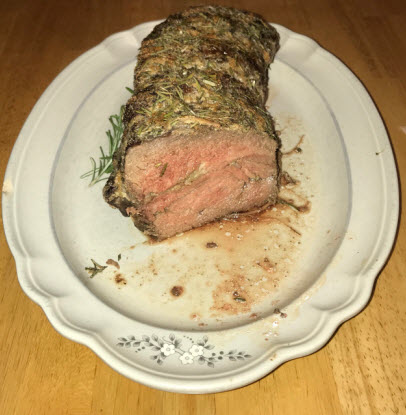
The reason that they don’t look as rare as cooking non-sous vide is that the slow, longer cooking slowly draws fluids out of the meat. 130F is still very much medium rare. The higher the temp, the more fluids are drawn out while cooking.
The general food safety guideline is to not cook for more than two hours at 130F (but the “tipping point” for killing off pathogens is actually 127F). Not everything dies at those temperatures though - spores still survive - so they could mature and become a problem if you left the finished product at room temperature for too long.
So, you can go much rarer for shorter cooks of thinner cuts if you like, but thicker cuts like a roast, the lowest I’d contemplate would be 127F.
If you dry the outside of your meat with paper towels before you do your sear, you can produce a thinner sear and it’ll take less time.
Are you shocking your food in ice water after processing Sous Vide? Going straight from Sous Vide to 15 minutes in the oven will overcook the outside, leading to the wide grey band seen in your picture. For sth like that, after Sous Vide, is shock down for ten or fifteen minutes before applying the sear. And then probably on the stove top or the grill, rather than the oven. Under the broiler maybe.
With a proper shock and sear, you should be able to get results like this
The opposite. I don’t really season most things in the bag. Maybe salt. That’s for anything I’d treat like a steak or roast. For a roast, I’d make an egg white wash, apply a thin thin coat after Sous Vide, then apply my spices to that tacky surface. This is after the shock, and probably after chilling completely, and the. Reheating in the oven to color the exterior.
Spices do not cook at Sous Vide temps. Sous Vide is extraction, not inception. Spices in the bag get meat flavored, beef in the bag does not get spice flavored.
I asked my husband to pick up whole milk mozzarella for a fathead pizza and all he heard was “whole milk” so now we have a half gallon taking up room in the fridge and we won’t use it.
Soooooo… 1/4 cup whole milk ricotta is less than 2 carbs net so I will get out my sous vide later and make some fresh ricotta!
How do you make that? Is it cultured - you add a little Ricotta to the milk and incubate? Or more like making mozzarella?
To be honest, I need to learn how to use my Anova before it gets here. They say Saturday.

